5 Effective Treatments for Plantar Fasciitis
Plantar fasciitis is a painful condition that affects roughly 10% of people at some point in their life. If you suffer from heel pain, especially when you first get up in the morning, or after running or standing for long periods, you very likely have plantar fasciitis. It’s a common problem that, thankfully, is almost always treatable using over the counter remedies at home.
Today, we are going to look at 5 different treatments for plantar fasciitis. Most of them you can do on your own with things you already own, or can purchase easily online. We’ll also explore what causes plantar fasciitis, and what you can do to prevent it in the future.
Treatment #1: Rest & Stretching
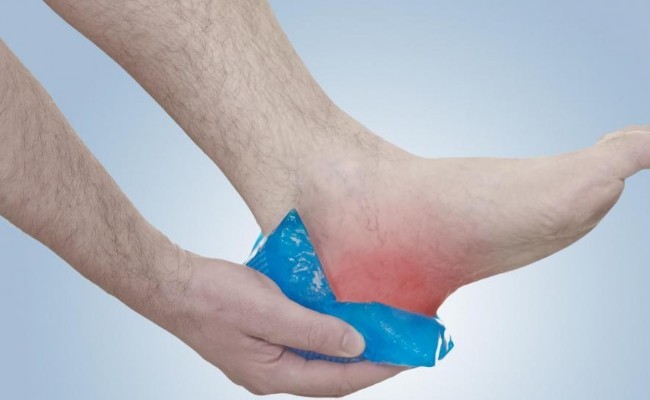
In most cases, plantar fasciitis is a temporary condition that will come and go over time. Many people find that rest, combined with applying heat and ice, is enough to soothe the pain and inflammation of the plantar fascia tendon. This is often the first thing a doctor will recommend because, frankly, in most cases it’s the best treatment for plantar fasciitis.
Once you have the swelling and pain to a minimum, the next thing to do is strengthening and lengthening the calf muscles. They are the muscle group that attaches to the plantar fascia tendon and the heel bone – so keeping them in proper shape can alleviate the stress put on the tendon.
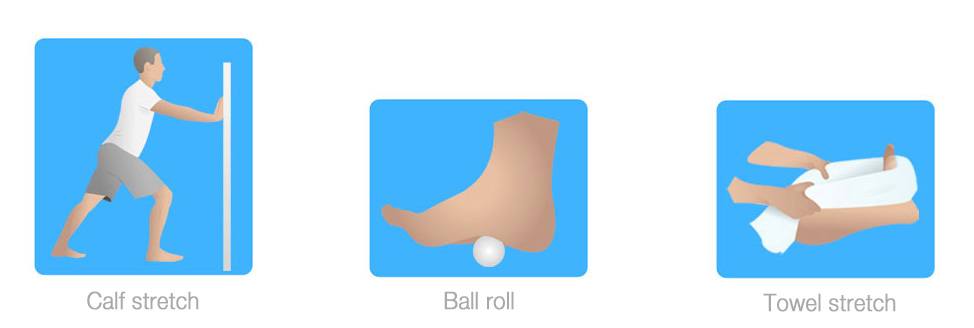
If you are currently suffering with heel pain and swelling, take stretching and exercise slowly, or wait until your heels feel better before taking this next step. One easy stretch to do is sit on the floor with the legs stretched out in front of you. Next, grab the toes and slowly pull them toward you, stretching the calf muscles slightly. If done slowly and over time, it will help stretch out the muscles and tendons. You can also do exercises like calf raises to strengthen the muscles, so they do more work than your tendons.
Treatment #2: Over-the-Counter Medication
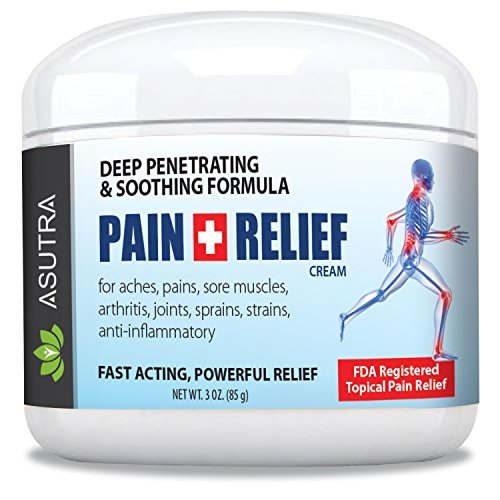
Another easy way to treat the symptoms of plantar fasciitis is to take an over-the-counter pain reliever. The most common medications that are recommended are nonsteroidal anti-inflammatory drugs, also known as NSAIDs.
Taking an NSAID like aspirin or ibuprofen can help reduce inflammation in the tendon and heel, while also reducing pain in the area. These can be helpful in managing pain, however they should not be taken for a long period of time. If your symptoms don’t get better with rest and OTC medication, you should talk to your doctor about other treatment options.
There are also topical pain and anti-inflammatory medications that can provide temporary relief of plantar fasciitis symptoms.
A great topical anti-inflammatory cream is Penetrex, which uses natural ingredients like arnica, vitamin B6, and boswellia serrata to reduce swelling and promote healthy tendons. As with any medication, you should use topical treatments carefully and follow directions to the letter to ensure you are using it safely.
Treatment #3: Orthotics, Socks & Night Splints
If strictly at-home treatments aren’t working, or you’d like to prevent further damage to your muscles and ligaments, using orthotics for plantar fasciitis is your next line of defense. There are several options on the market that you can easily insert into your shoes to relieve pain, and prevent plantar fasciitis from returning in the future. Here are just a few of our favorites!
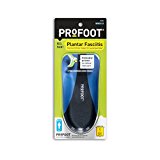
Profoot Plantar Fasciitis Orthotics
I’ve highly recommended Profoot products on our site many times, and they make great plantar fasciitis heel cups that fit into almost any shoes. They make a version specifically for men’s shoes, and another one for women.
Wanderlust Plantar Fasciitis Sleeves
If adding orthotics to your shoes isn’t feasible, or you want to try another method, consider using compression socks or sleeves on your feet. I think the Wanderlust sleeves are great to use alone or in addition to shoe inserts. They will help with overall swelling around the heel and ankle, and provide better support while you’re healing.
StabilityAce Plantar Fasciitis Night Splint
For many people, plantar fasciitis flares up at night while they sleep, making getting up and around in the morning slow and painful. Using a plantar fasciitis night splint, like this one from StabilityAce, can help slowly stretch the tendons and muscles overnight, and prevent morning stiffness and pain. If you find that none of these treatment options are working, or your pain gets worse, it’s time to talk to your doctor. Often, increased pain and swelling is due to additional problems with the heel bones and tendons, or you may have heel spurs that need to be removed. Your doctor does the next two treatments, but in severe cases, they may be necessary for recovery and prevention.
Treatment #4: Corticosteroid Injections
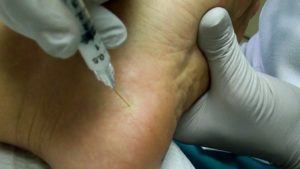 In the event your swelling and pain don’t improve, or they get worse, it’s time for more aggressive treatments. Your doctor may suggest injecting the area with a corticosteroid to provide pain relief and reduce swelling of the muscles and tendon. This is a treatment done in many areas of the body, and can provide much needed relief if done properly.
In the event your swelling and pain don’t improve, or they get worse, it’s time for more aggressive treatments. Your doctor may suggest injecting the area with a corticosteroid to provide pain relief and reduce swelling of the muscles and tendon. This is a treatment done in many areas of the body, and can provide much needed relief if done properly.
The main reason this isn’t done more frequently is that it’s only a short-term option, and not a very effective one. Many people find it relieves pain for only a month or so, which isn’t long enough to truly heal the area. Dulling pain on such a high level also creates a false sense that the area is cured, which increases the person’s chance of injuring themselves further. There is also a risk of rupturing the tendon during the injection, or getting an infection in the area since it’s a place that’s prone to bacteria and excess moisture.
Most doctors will tell you this isn’t the best option – prolonged rest and ice/heat treatments are far more effective at treating the problem. Masking the symptoms is nice, but it doesn’t solve the problem itself.
Treatment #5: Surgery
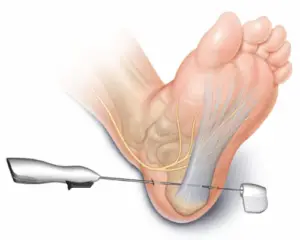 Plantar fasciotomy or other surgical options are considered a last-resort option for treating plantar fasciitis. You need a specialist to perform these operations, and the recovery time can take months to fully heal. Doctors do not recommend these unless absolutely necessary.
Plantar fasciotomy or other surgical options are considered a last-resort option for treating plantar fasciitis. You need a specialist to perform these operations, and the recovery time can take months to fully heal. Doctors do not recommend these unless absolutely necessary.
A plantar fasciotomy is an orthoscopic surgery that involves purposely tearing/cutting the plantar fascia to elongate it. This is an effective surgical option, and it’s minimally invasive procedure. However, the recovery can take several months, in which time you’ll need to keep weight off it by using crutches, splints, and boots.
The only other surgical option I’ve seen online is when a doctor finds bone spurs that need to be removed. Bone spurs are small shards or growths of bone that rub up against the tendon, causing it to swell and tear. Removing the bone spurs can prevent further damage to the tendon, and hopefully help it to heal. The recovery time can also take months, and there is no guarantee that it’s a permanent fix – bone spurs could return over time, requiring additional surgery.
Plantar Fasciitis: An Overview
What is plantar fasciitis?
Plantar fasciitis is a heel and foot disorder that causes pain and swelling in the heel. It occurs when the plantar fascia is overworked or injured, and is often made worse when the Achilles’ tendon is stretched or torn.
What causes plantar fasciitis? Are some people more prone to it than others?
Doctors don’t know the exact cause of plantar fasciitis, since it is so common and seems to happen to a variety of people. There are some risk factors that are common among people who get plantar fasciitis, or who get it frequently. These risk factors are:
- Spending extensive time on your feet throughout the day
- Being overweight or obese
- Excessive exercise, especially running or jumping
- Little to no exercise
- Feet rolling inward while walking
- Wearing high heels for long periods of time
How can I prevent plantar fasciitis?
Since doctors don’t have a clear idea of what causes plantar fasciitis, preventing it is also not entirely possible for some. Some people are just prone to getting it more often, and there isn’t much they can do about it. However, there are some things you can do to try and prevent symptoms from coming back (or not as badly the next time). Here are a few things you can do to increase your success in preventing plantar fasciitis:
- Wear proper footwear that fits and doesn’t put stress on the heel
- Avoid wearing heels every day – switch off between heels and flats
- Try to take breaks from standing/walking throughout the day
- If you lead a sedentary life, get up and walk around more throughout the day
- Consider getting running shoes fitted by a professional
- Use orthotic inserts and compression socks every day
- Continue stretching the heels and calves each night, and continue strength training for calf muscles
- Soak feet in Epsom salts each week, or whenever you need it, to reduce swelling/pain
